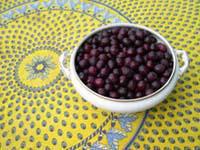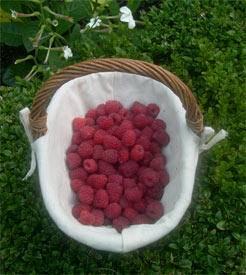Two recipes: Wild Damson Gin and Sloe Gin recipes
Posted by Fiona Nevile in Liqueurs | 713 comments
Wild damsons are a beautiful rich dark colour
Unlike sloes, wild damsons are hard to find. For every thirty wild plum trees there may be just one wild damson tree. When I spot wild damsons in the hedgerows, they are harvested into a special bag.
These, and the diminutive bullace, are the kings of hedgerow fruit. These tiny fruit make such an irresistible liqueur that overnight guests have actually turned down Danny’s famous cooked breakfast, and gone back to bed to sleep off the excesses of the night before.
Our damson and sloe gin is not the thick ultra sweet variety. We prefer the sugar to enhance rather than shield the flavour. Every three months or so it’s sampled and, if necessary, topped up with sugar. Usually no extra sugar is needed.
We try to keep our damson and sloe gin well away from the drinks tray! Each year we make a lot of fruit gin and vodka (more recipes to follow, in time). Sloe gin is the big craze at the moment around here, as sloes are more plentiful.
Here are our recipes for both. We are also starting experimenting with sloe gin see this post for details
Tips and tricks:
- Make more than you need the first year, so you can compare different vintages. This liqueur does improve over time.
- Some people drain the grog through muslin after a couple of months, to clarify the liqueur and bottle. We don’t bother as one old soak tipped that, once the gin is drunk, you can pour medium sherry on the fruit and start all over again! The latter is devilish and drinkable within three months. We have a recipe for this in our wine and gin section.
- Keep your fruit gin away from the light as this will maintain the colour. Unless it is in a dark green or brown bottle. Wrapping it in brown parcel paper will keep out the light.
- Make notes on a label of your fruit gin/vodka /sugar ratio and stick it onto the bottle(s) so that you have a record, if you make a particularly good batch. We note our responses as the grog matures. Yucky after sixth months can be to die for in a year (you will probably not remember without notes). Notes seem boring when you are making the grog but they are so worthwhile when you start again the next year. It won’t be long before you will get a feel of what works well for your taste (and the notes will come into their own).
- Adding almond essence to sloe gin lifts it from good to great. I haven’t tried this with the damson gin but return in a years’ time for our review.
- Don’t kill the liqueur with too much sugar at the start. Use the amount above to start your sloe or damson gin and then every couple of months take a tiny sip. At this time add more sugar if it is too sharp for your taste.
- Gin v Vodka? Vodka can be used as the spirit for these recipes. Although I’m a vodka drinker, we tend to stick to a gin base for our fruit liqueurs.
- A good damson gin can be made from ordinary damsons available in the shops. As they are bigger you would need to put them into a larger Le Parfait jar (I’d use a 2 litre size).
- People have been picking sloes from September 1st around here. Some people say that you shouldn’t pick sloes until after the first frost. This can be circumvented by putting your sloes in the freezer overnight. We don’t bother with either method and always have great results.
- This year we have made up a number of small (1lb honey jars) of sloe gin to give as Christmas presents.
| Wild Damson Gin and sloe gin Recipes |
- Wild damson gin:
- 1lb/454gm of washed wild damsons
- 6 ozs/168gm of white granulated sugar
- 75cl bottle of medium quality gin
- Sterilised 1 litre (at least) Le Parfait jar or wide necked bottle with stopper/cork
- Sloe Gin:
- 1lb/454gm of washed sloes
- 4 ozs/112gm of white granulated sugar
- 75cl bottle of medium quality gin
- Sterilised 1 litre (at least) Le Parfait jar or wide necked bottle
- 1-2 drops of almond essence
- Wild damson gin:
- Wash damsons well and discard any bad or bruised fruit. Prick fruit several times with a fork and place damsons in either a large
- Kilner/Le Parfait jar or a wide necked 1 litre bottle.
- Using a funnel, add the sugar and top up with gin to the rim.
- Shake every day until the sugar is dissolved and then store in a cool, dark place until you can resist it no longer (leave for at least three months, we usually let it mature for a year). If you are planning to drink this after 3 months, have a nip afetr a month, and top up with sugar to taste.
- Some people strain the grog (through muslin/jelly bag) after 3 months and bottle it, leaving it mature for six months. We strain and bottle after a year. Don’t leave the straining process any longer than a year; leaving the fruit in too long can spoil the liqueur, as we found to our cost one year.
- Sloe gin:
- Wash sloes well and discard any bruised or rotten fruit. Prick fruit several times with a fork and place sloes in either a large Kilner/Le Parfait jar or a wide necked 1 litre bottle. I put several sloes in my palm to prick them rather than picking them up one by one.
- Using a funnel, add the sugar and top up with gin to the rim. Always open sugar bags over the sink as sugar tends to get caught in the folds at the top of the bag.
- Add the almond essence.
- Shake every day until the sugar is dissolved and then store in a cool, dark place until you can resist it no longer (leave for at least three months, we usually let it mature for a year).
- Some people strain the grog (through muslin/jelly bag) after 3 months and bottle it, leaving it mature for six months. We strain and bottle after a year.
Leave a reply






Have made both damson jam and sloe gin for years (drinking last year’s now!!), but am determined to keep some damsons back from the jam pot in order to make damson gin this year. Just had a great time reading all your tips, so thought I’d give you one of my own. We recycle the 5ltr plastic containers that we buy vinegar in (I make heaps of chutney as well) and use them for gin making. Once rinsed and sterlised they’re great as the neck is wide enough to get the fruit into easily, the resultant gin is easily decanted and the waste remains nicely packaged for disposal!
Hi,
Great damson and sloe gin recipes, have been out collecting damsons and blackberries today. Has anyone tried making blackberry gin, thought we might give it a go.
Hi Louisa,
Great to get the update.
It’s fun using garden/hedgerow produce to make tasty preserves and gin. It™s one of my favourite passions.
Thanks for the tip about ‘The Range’ in Gosport, Hampshire.
hi,
Just thought i’d say thanks to everyone for the tips and recipes and where to get jars from. I found some great cheap le parfeit jars from “The Range” in gosport hampshire. Had a bumper crop of elderberries in the garden this year so i’ve had a bash at making elderberry gin (thanks for the tips) it already looks a fantastic colour and i look forward to sampling it. Have also made some wild damson gin, just the sloe gin to go and might make some damson vodka. Had so much fruit in the garden this year that i,ve had a go at making plum jam, wild damson jam and elderberry jelly, never made anything like this before in my life, but really enjoyed myself, now i just have to find enough people to eat it all lol.
20lbs of sloes, what a daemon forager you are Christof!
I’d love to hear about you cider making secrets so I am going to email you immediately.
Thanks for taking the trouble to return with an update. It is different all over the country. The wild plums are not quite ready around here, haven’t had a mo to check the sloes yet.
Greetings once again from Portland, site of the 2012 sailing olympics :).
Just an update to what I said about the Sloes being ahead. Checked my island stock and it seems they are only a couple of weeks ahead. So on the whole things are advanced but different sites are at different stages. What is making the difference it seems is the amount of sun a site gets. The sloes on the island are shaded in the parts where I go.
As for the cider am more than happy to help you out. Drop me a line to Arachne75@hotmail.com Its more to do with how you do it than what you use, I find with cider. Trouble is I love the fresh juice just as much as the cider, so I have to watch that not too much gets frozen down in juice form lol 🙂
This year I am intending to freeze my sloes down first, to try out the practice of waiting for the first frosts to bruise the fruit. However I am using my chest freezer to do mother natures work for me lol.
Have managed to collect about 20lb of sloes so I intend to lay down right up too christmas… 🙂
Christof 🙂
Hi Darren,
Thanks for leaving a comment! Hope that your damson gin is a success. Sorry but I don’t know of a good recipe for strawberry vodka. Perhaps someone out there does?
hi
Just wondered dose anyone now of agood recipe for making strawberry vodka.If so please could you let me now.
Many thanks
Darren
p,s
GREAT WBSITE :~}
Hi eveyone
Just bought 1 1/4lb Damsons from a road side farm up in the lake looking forward to making some Damson gin for the first time.
so thanks for the recipes will let you all how i get on.
thanks Darren
Hi Keith,
Thanks for dropping by. Hope the damson gin works out well for you!